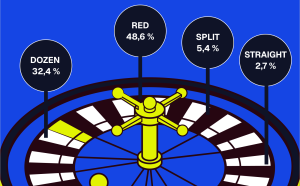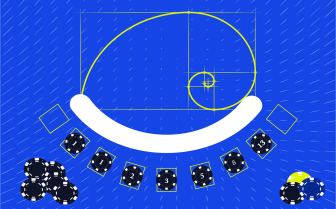Table of content
Roulette has always been a well-liked game in the online casino industry, thanks to its spinning wheel and the attraction of chance. Although luck plays a big part, many players look for ways to reduce risks and prolong their gameplay. The Fibonacci System is one such tactic that has become popular over time.
Origins and Mathematical Basis
Leonardo of Pisa gave the Fibonacci sequence in his book “Liber Abaci” in 1202. The sequence starts with 0 and 1, and each subsequent number is the sum of the two preceding ones (0, 1, 1, 2, 3, 5, 8, 13, and so on). Initially designed to model rabbit population growth, this sequence found its way into various fields, including gambling strategies.
How the System Works
It’s typically applied to even-money bets like red/black or odd/even in roulette. Following the Fibonacci sequence, the fundamental principle is to increase your bet after a loss and decrease it after a win. I played it, and if your initial bet is $1 and you lose, your next bet becomes $1 (0 + 1). If you lose again, it becomes $2 (1 + 1). After a win, you move back two steps in the sequence, so if you win after the $2 bet, your next bet is $1 (2 – 1).
Sequence | Stake | Outcome | Profit |
|---|---|---|---|
1 | 1 | Lose | -$1 |
1, 2 | 2 | Lose | -$3 |
1, 2, 3 | 3 | Lose | -$6 |
1, 2, 3, 5 | 5 | Lose | -$11 |
1, 2, 3, 5, 8 | 8 | Win | $5 |
1, 2, 3 | 3 | Lose | $2 |
Key Principles for Low-Risk
The Fibonacci System’s appeal as a low-risk strategy lies in its gradual betting progression. Unlike aggressive strategies that can lead to substantial losses quickly, the Fibonacci approach allows players to recover losses progressively and avoid large bets. This systematic approach can extend gameplay and reduce the impact of unlucky streaks.
Step-by-Step Implementation
I tested it, and to implement the Fibonacci System, start with your base bet. If you lose, move one step forward in the sequence and increase your bet accordingly. If you win, move two steps back and decrease your bet. Continue this pattern until you reach your desired profit or decide to quit.
Illustrative Example
Suppose your base bet is $1, and you encounter the following sequence of results: Loss, Loss, Win, Win, Loss, Win. Your bets would progress as follows: $1, $1, $2, $1, $1, $2. You can see how the system helps recover losses while keeping bets manageable.
Why do Low-Risk Strategies Matter?
Low-risk strategies like the Fibonacci System are attractive because they buffer against substantial losses. They align to enjoy roulette over a more extended period rather than chase big wins. This approach emphasizes risk management and disciplined betting.
Limitations and Downsides
Recognizing the Fibonacci System’s limits is essential even though it provides a logical strategy for playing roulette. It does not ensure success and can lead to losses, particularly over the long run. Furthermore, it is based on the unrealistic notion that each player has an endless bankroll.
Real-Life Successes
When playing roulette, the Fibonacci System has been successful for many players. Some people have had incredible winning streaks when they turned little winning bets into large winnings. These tales, however, frequently entail a mix of good fortune and perseverance.
Realistic Outcomes
The fact that roulette is primarily a game of chance must always be considered. Although the Fibonacci System can aid with risk management, there is no surefire way to win consistently. Players should be ready for both wins and losses since both are realistic outcomes.
Exploring Variations
The base wager can be changed, and alternative sequences like the Reverse Fibonacci can be used as variations of the Fibonacci System. By changing the progression rate, players can modify the strategy to meet their level of risk tolerance.
When to Use It?
The Fibonacci System is most effective for roulette players who want to play slowly and methodically. It can be a valuable tool for controlling risk. Still, depending on their objectives and resources, participants must know when to use it and when alternate techniques could be preferable.
Final Words
The Fibonacci System emphasizes gradual betting progression and risk management, providing a low-risk roulette strategy. Roulette has tremendous attraction, but it’s essential to approach it realistically and recognize that luck will always play a big part.
Page Information
Topics
StrategiesRelated

Players often ask this question to determine whether participating in a certain game might break any laws, regulations, or fundamental principles. In this article, we’ll explore what gambling actually means and why understanding it is so important.

Roulette is simple, fun, and timeless. This guide covers the rules, wheel types, payouts, and strategies you need to play smarter and enjoy every spin.

Knowing the odds in roulette helps you make informed bets and understand exactly what you’re risking with each spin.

Roulette offers a variety of bet types, each with its own risk level and payout, letting players choose between safer options and high-reward wagers.




